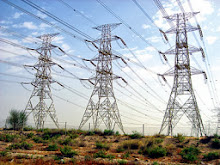DC Generator Theory
DC Generator Theory
DC generators are widely used to produce a DC voltage. The amount of voltage
produced depends on a variety of factors.
Voltage Production
Recall from Module 3, DC Circuits, that there are three conditions necessary to induce a voltage into a conductor.
- A magnetic field
- A conductor
- Relative motion between the two
A DC generator provides these three conditions to produce a DC voltage output.
Theory of Operation
A basic DC generator has four basic parts: (1) a magnetic field; (2) a
single conductor, or loop; (3) a commutator; and (4) brushes.
The magnetic field may be supplied by either a permanent magnet or an
electromagnet. For now, we will use a permanent magnet to describe a
basic DC generator.
| Fig(1) Basic Operation of a DC Generator |
A single conductor, shaped in the form of a loop, is positioned
between the magnetic poles. As long as the loop is stationary, the
magnetic field has no effect (no relative motion). If we rotate the
loop, the loop cuts through the magnetic field, and an EMF (voltage) is
induced into the loop.
When we have relative motion between a magnetic field and a conductor
in that magnetic field, and the direction of rotation is such that the
conductor cuts the lines of flux, an EMF is induced into the conductor.
The magnitude of the induced EMF depends on the field strength and the
rate at which the flux lines are cut, as given in equation (5-1). The
stronger the field or the more flux lines cut for a given period of
time, the larger the induced EMF.
The direction of the induced current flow can be determined using the
"left-hand rule" for generators. This rule states that if you point the
index finger of your left hand in the direction of the magnetic field
(from North to South) and point the thumb in the direction of motion of
the conductor, the middle finger will point in the direction of current
flow . In the generator shown in Figure 2, for example, the
conductor closest to the N pole is traveling upward across the field;
therefore, the current flow is to the right, lower corner. Applying the
left-hand rule to both sides of the loop will show that current flows in
a counter-clockwise direction in the loop.
| Fig(2) Left-Hand Rule for Generators |











0 comments:
Post a Comment